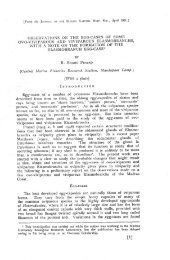PDF - Eprints@CMFRI
PDF - Eprints@CMFRI
PDF - Eprints@CMFRI
You also want an ePaper? Increase the reach of your titles
YUMPU automatically turns print PDFs into web optimized ePapers that Google loves.
145<br />
G e n e ric c h a r a ct e r s: Solitary, free or fixed, turbinate or saucer-shaped. Calyx sub circular.<br />
Septa in five cycles. Major septa highly exsert and arched, swollen at the theca; upper part of these septa<br />
entire and lobulate, lower outer part with teeth. A conspicuous set of pali present. Costae distinct.<br />
Cynarina lacryrnalis (MILNE EDWARDS and HAIME), 1848<br />
(Plate H. Fig. 6)<br />
Caryopbyllia<br />
CYriarina<br />
Caryophyllia<br />
Scleropbyllia<br />
Cynarina<br />
/acrymalis 1848 . MILNE EDWARDS & HAIME. t. 11 :238: t. 10: pI. Sl l , l a (Typ~ locality : Philippines:<br />
arter CHEVALIER , 1975 . type: is lost).<br />
lacrymalis 1964a, WELLS. 376; pis. 20/ 1- 5: 21/1 - 6 (synonymy).<br />
1975. CHEVALIER, 293 ; pis. 2612 , 3; 2716 (synonymy).<br />
1976. PILLAI & SCHEE R. M , pi. 28/1 . 2.<br />
1980. VERON & PICHON. 238, figs. 396- 401. 770.<br />
c! carduus 1828. AUDOUIN (& SAVIGNY I). 54 ; pI. 4/ 2 .<br />
margariticola 1879 . KLUNZINGE R 3, 4 : pI. 1112 .<br />
1907 •. VAUGHAN, 258.<br />
1911. GRAV IER, 42 ,pi. 11 /45.<br />
1924-, MATIHAI, 33 .<br />
savignyi 1877a. BR UEGGEMANN, 305 .<br />
1879, KLUNZINGER 3. 4.<br />
1952. CROSSLAND. 137, pI. 4/1 . 2.<br />
There are six specimens in the present collection. The largest is 55 mm in greater diameter. The primary<br />
septa are the thickest and most exsert in majority of specimens, but in one (NS 607 1) the first two cycles<br />
are subequal. The number of teeth range from 3 to 5. Pali very conspicuous in primary septa. The edges<br />
of septa of higher cycles have serrations representing teeth, these septa are not swollen as those of lower<br />
cycles. Two to three cycles of septa unite with the columella. Columella composed of closely twisted<br />
trabeculae. The specimens are cornuate ( S 6071) or saucer-shaped. The base is narrower than the top.<br />
We have also seen KLU ZINGER 's type of Scleropby/lia rnargariticula, No. 2181 in Berlin Museum .<br />
Material:<br />
Gulf of Aqaba: Jerus. SLR 364- 2 (Marsa Murach) ; 1241 (Fara'un Isl. ).<br />
T. Aviv NS 6071,6114,6116 (Eilat).<br />
Basel PW 73 573a (Eilat , 50- 55 m, juv., attached to Coscillaraea rnonile).<br />
Dis t rib uti 0 n : Red Sea; Madagascar; Maldives; Ceylon ; India (the locality of the Indian Museum<br />
specimen, reported by MATTHAI, 1924, is not known); Borneo; China Sea (BASSET-SM ITH , 1890);<br />
Philippines; Japan ; Great Barrier Reef; New Caledonia; Loyalty IsIs. ; Kermadec IsIs.<br />
Genus Lobopbyllia de BLAINVILLE, 1830<br />
Ty pes p e c i e s: Madrepora coryrnbosa FORSKAL, 1775.<br />
G e n e ric c h a r act e r s : Phaceloid . Corallites monocentric or in longish valleys , 15 mm in diameter<br />
to 5 or 7 cm in length and 10 to 20 mm wide. Septa thick, highly exsert with large teeth. Columella<br />
centres dintinct, adjacent ones in a valley linked by lamellae.<br />
MATTHAI (1928) in his revision of Lobopbyllia recognized three species, viz L. corymbosa, L. costata<br />
and L. bempricbii. CROSSLAND (1931) made a critical examination of the genus in Tahiti and felt that<br />
all the above mentioned species can be growth forms of one and the same. However, 1952 he separated<br />
L. coryrnbosa from L. bempricbii. It is interesting to note that specimens, labelled by MATTHAI as L.<br />
costata, were reported by CROSSLAND as L. bempricbii, which shows that these two great workers could<br />
not agree on the determination due to lack of any definite distinguishing features between L. costata and<br />
L. bempricbii. STEPHENSON & WELLS (1956) also felt that all of MATTHAI's "vaLid " species may represent<br />
a single good species. However, in this work we regard L. corymbosa and L. bempricbii as separate. L.<br />
costata is not separable on any sound basis.<br />
Key to the species of Lobopbyllia from Red Sea:<br />
I . Corallites mostly monocentric, but with occasional di- or tricentric valleys. .. . . ... . L. corymbosa
















